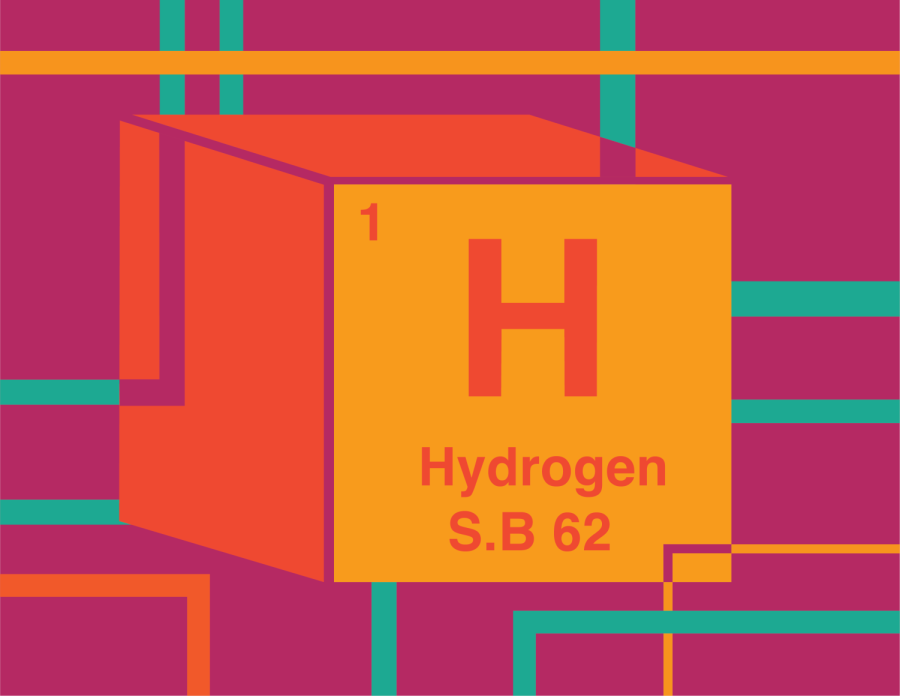Barney: The Future of Transportation Isn’t just Electric
(Graphic by Mary Allen | The Daily Utah Chronicle)
February 17, 2023
When we talk about solving climate change, we typically offer the electrification of appliances and utilities as one solution. Of course, this solution must accompany renewable energy initiatives to be effective.
Electric vehicles (EVs) are becoming more common, with many automotive companies planning to nix the internal combustion engine in the next couple decades. However, EVs have serious shortcomings, which extend to the engineering challenges behind the electrification of the rest of our utilities.
S.B. 62 recognizes this and seeks to open research that takes advantage of hydrogen power, which is exactly what we need. We should consider more energy sources than only renewables as we try to migrate away from fossil fuels. Hydrogen power has great potential.
S.B. 62 directs the creation of a hydrogen advisory council, which will advise and promote the research and development of hydrogen products. This includes using hydrogen as an energy source and possibly as fuel for transportation. This council will try to secure federal funding for these types of projects, working with both public entities and private companies to set goals related to hydrogen engineering.
Very few companies offer hydrogen-powered vehicles, and those that do offer them at high prices. The market is small because there hasn’t been enough research conducted and infrastructure created to adequately allow the industry to fully incubate.
According to Dr. Kody Powell, co-director of the Intermountain Industrial Assessment Center at the University of Utah, “Exploration into hydrogen vehicles and doing these pilot projects and turning these into real world case studies is valuable.” S.B. 62 could be the push that these companies need to make hydrogen more accessible in Utah.
Hydrogen’s benefits aren’t immediately obvious when compared to renewables and fossil fuels. However, their pros and cons are a great compromise between the two. The most straightforward utility to compare these types of energy sources are vehicles.
Electric vehicles are powerful but require large batteries to function. Those batteries have limited range, with the current average producing 211 miles per charge. For basic commutes, this isn’t a problem. However, we use vehicles for much more than getting to work. As they currently exist, EVs don’t provide an adequate replacement for gas vehicles in commercial transportation. The size of battery required to move cargo significant distances is too large to be practical at scale. Furthermore, batteries have the disadvantage of limited recharge rates and relatively quick degradation.
Refilling a gas-powered vehicle takes a fraction of the time required to charge an EV. The caveat to this speed, however, is its carbon footprint. Combustion engines work by creating a combustion reaction between a mix of octane and other fuel combinations to spin a motor and create motion. The byproducts of this reaction are water and carbon dioxide.
Hydrogen vehicles (HVs), on the other hand, have the speed of gas while maintaining a green footprint. Hydrogen engines use the same combustion concept, but instead of using octane, they use hydrogen gas. The byproduct of that combustion is only water. This is a much cleaner reaction and eliminates the need for internal combustion engines.
HVs provide the convenience of gas, with a footprint similar to EVs. This extends to energy production and storage. Fossil fuels are extremely convenient, they can be put anywhere and maintain their efficiency. Renewable energy sources like solar and wind can only be put in specific places, and their efficiencies are dependent on the climate and locations chosen – being green is extremely inconvenient. Hydrogen is a healthy mix.
Some hydrogen energy projects, such as the ACES Delta project in Delta, Utah, aim to solve some of the infrastructure and supply issues hydrogen faces. “When electricity is produced, it basically has to be consumed instantaneously unless you have some kind of huge storage resources to absorb the fluctuations … if we wanted to flip this switch and suddenly be ‘100% renewable energy society,’ we’re just nowhere near that right now. It’s going to be a major technological hurdle that we’re going to have to overcome as a society,” Dr. Powell said.
More infrastructure investment is necessary for hydrogen energy to be viable at scale, but this is a start. We can’t truly know which solution is best until we’ve given both a fair shot. Even so, there doesn’t have to be one winner.
The transition from fossil fuels to renewable energy sources is essential, since they will run out some day, but it doesn’t have to be a head-first dive. We can aid our transition by utilizing greener energy sources, like hydrogen. We need hydrogen research to help make our future greener.
We should still encourage the expansion of the electric market, since many of their shortcomings could become solvable given time, research and investment. But this shows electric doesn’t have to be the only solution.
Bills like S.B. 62 are a great solution to parts of the climate crisis. Research and development into alternative energy sources is exactly how we can avoid catastrophe and transition into a renewable society.










graceflex hu • Sep 14, 2023 at 10:16 pm
EV Solar panel charging as part of a gasoline car is the best option, and the time required to refuel a gasoline-powered car is a fraction of the time required to charge an electric car. However, the caveat to this speed is its carbon footprint. Internal combustion engines work by creating a combustion reaction between a combination of octane and other fuels that spins the engine and creates motion. The by-products of this reaction are water and carbon dioxide.